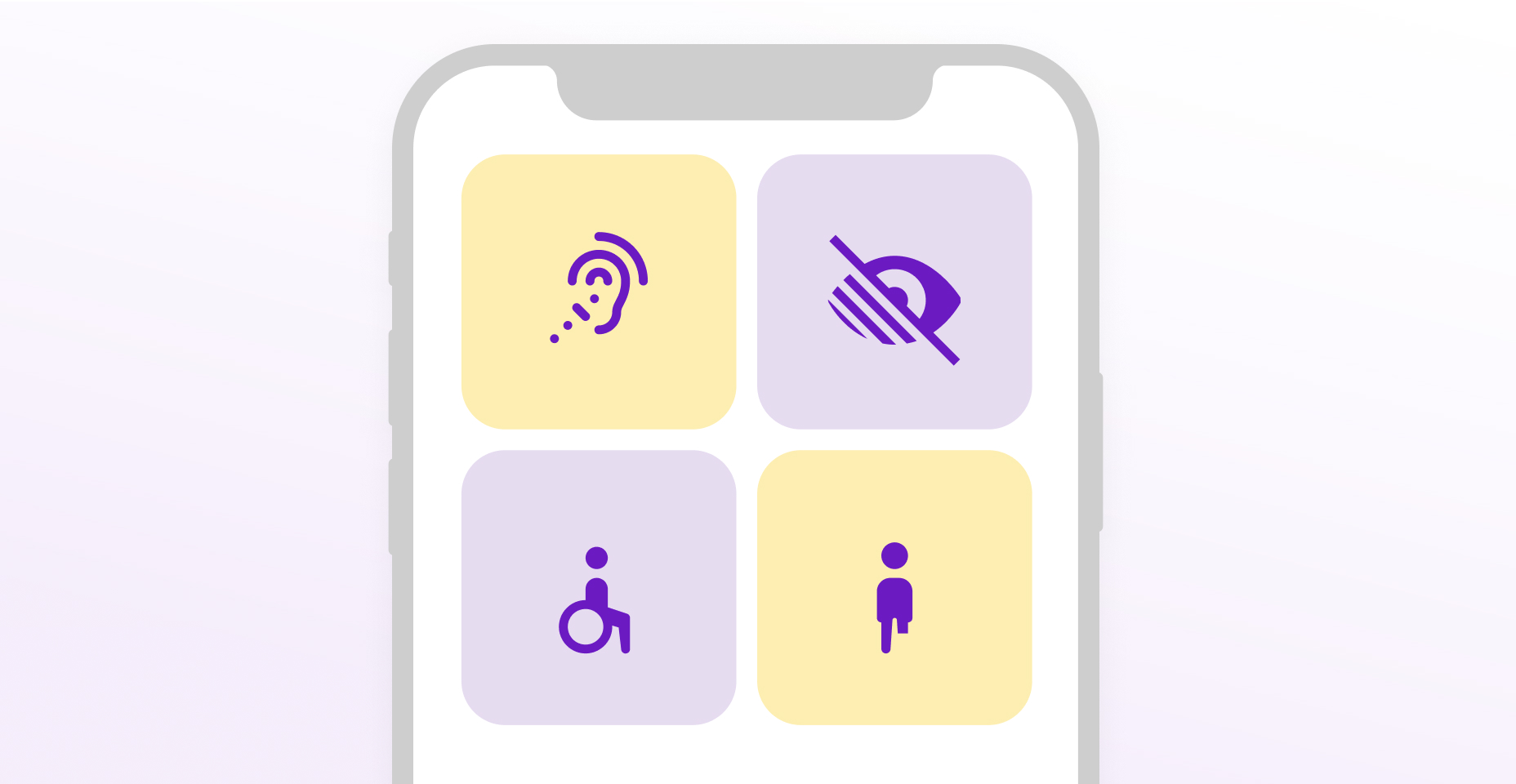NEW LAUNCH: Weill Cornell Medicine's Maya app is now available for Android!
NEW LAUNCH: Weill Cornell Medicine's Maya app is now available for Android!
At Heady we believe everyone should be able to use and benefit from the digital products we build — that’s why we’re passionate about Inclusive Design and Accessibility.
 We believe it’s essential for designers (and anyone who works on digital products and services) to understand the principles of Inclusive Design and Accessibility in order to create designs that are truly usable for and enjoyable by everyone.
We believe it’s essential for designers (and anyone who works on digital products and services) to understand the principles of Inclusive Design and Accessibility in order to create designs that are truly usable for and enjoyable by everyone.
Inclusive Design is a design methodology that seeks to accommodate and benefit from the diversity of human abilities, characteristics, and needs. This includes designing for individuals with disabilities, but it also involves considering the needs of people of different ages, cultures, and linguistic backgrounds, in order to create products, services, and environments that can be used and enjoyed by the broadest possible range of people.
The intent of Inclusive Design is to create products that understand and enable people of all backgrounds and abilities, regardless of their:
Inclusive Design is more than just designing for specific groups of people. It's about designing with all users in mind, rather than just a select few. This approach, sometimes referred to as "Designing with, not for," involves bringing the people you’re designing for into the design process as active participants from the very beginning.
By considering the needs of all users, Inclusive Design helps create truly inclusive and accessible products, services, and environments. In addition to the social and ethical benefits of Inclusive Design, there's also a strong business case for it which we’ll discuss a bit later.


Accessibility refers to products, services, and environments designed to be usable by people with disabilities. This includes individuals with permanent, temporary, or situational disabilities, such as those who are blind or have low vision, deaf or hard of hearing, or who have mobility impairments.
Designing for accessibility requires the consideration of several different areas of focus, including but not limited to:
Accessibility is an important aspect of design because it ensures that people with disabilities are able to access and use the products and services we create. By considering the needs of people with disabilities in the design process, we can create designs that are more inclusive and accessible to everyone.
Designing for accessibility not only benefits individuals with disabilities, but also has wider benefits for society as a whole. By creating products, services, and environments that are accessible to everyone, we can increase the overall accessibility and usability of our built environment. This contributes to creating a more inclusive society where everyone has the opportunity to participate fully and independently in all aspects of life. And much like with Inclusive Design, beyond the social and ethical benefits there’s also a business case for designing with accessibility in mind.


While Inclusive Design and Accessibility often go hand in hand, they aren’t the same thing. Inclusive Design can be thought of as the "input": the processes, practices, and people that go into designing products, services, and environments that are accessible and usable by everyone. It's about considering the needs of all users, not just a select few, and creating designs that are truly accessible to everyone.
On the other hand, Accessibility is one of the many "outputs" of these inclusive practices; it’s the end result of designing for people with disabilities and a wide range of abilities. This includes designing for people who are blind or have low vision, who are deaf or hard of hearing, or who have mobility impairments. Accessibility is a crucial aspect of Inclusive Design because it ensures that people with disabilities are able to access and use the products and services we design. That being said, they’re both important design considerations that often overlap in practice.
Simply doing the right thing is a key aspect of Inclusive Design, but it’s also about creating better designs. When products and services are designed with the needs of all users in mind, they’re easier to use for everyone, regardless of their individual abilities, backgrounds, or needs. This means that people with disabilities are able to access and use these products and services, but it also means that people without disabilities will have a more positive experience as well.
Beyond creating designs that are more usable and enjoyable for everyone, there’s a strong business case for Inclusive Design. Companies that prioritize Inclusive Design often see an increase in customer satisfaction, which can lead to increased brand loyalty and positive word-of-mouth. Inclusive Design can also help decrease time and money spent on customer support, because products and services that are designed with the needs of all users in mind are typically easier to use.
Inclusive Design can also help a company reach a wider market by allowing them to serve a greater number of potential customers. According to the Centers for Disease Control, around 15% of American adults report trouble hearing, while 6% of Americans 12 or older have visual impairments. By designing products, services, and environments that can be used by the widest possible range of people, a company can tap into new market segments and potentially increase its customer base. In other words, Inclusive Design is a win-win for everyone involved: It not only benefits all users, it can also bring significant value to a brand.
This dual perspective is exactly why we prioritize Inclusive Design at Heady. It’s part of our unique value proposition to our clients and partners, as well as to our users. By considering our human responsibility, the ethical benefits, and the business value, Inclusive Design allows us to ship products that are a win-win for all.


It's worth noting that designing for Accessibility isn’t just about making digital products easier to use for people with disabilities, but also about complying with the Americans with Disabilities Act (ADA). Enacted in 1990, the ADA says that businesses and organizations must make their public spaces accessible to people with disabilities. While this historically focused on physical accommodations like wheelchair ramps and accessible parking spaces, in more recent years the Department of Justice has also issued accessibility guidelines for digital spaces.
While ADA compliance is not mandatory for websites and mobile apps unless they receive federal funding, many states have adopted their own accessibility laws and dozens of website accessibility-related lawsuits have been filed against companies in recent years. Ensuring compliance with ADA guidelines can help organizations prevent legal issues and negative PR.
But designing for accessibility has plenty of other benefits for businesses and organizations beyond just avoiding lawsuits. Accessible websites and mobile apps are easier for everyone to use, regardless of their individual abilities or needs. Products that are easy to use often see increased user engagement and can potentially drive more traffic to a website or mobile app. And by designing with Accessibility in mind from the very start, companies can save money on potentially course-correcting for users down the road.
So accessibility isn’t just about doing the right thing — it can also have a positive impact on a business's bottom line. By considering the needs of all users in the design process, organizations can create more inclusive and accessible products, services, and environments that can be used and enjoyed by everyone while also protecting and benefiting their brand.


Inclusive Design doesn't just make things better for the people using our products and services, it also leads to greater innovation and a brighter digital future. By considering the needs of a diverse group of users, designers are forced to think creatively and come up with new solutions. This can lead to the development of products and services that are not only accessible, but also more innovative and user-friendly for everyone.
At Heady, we’re committed to practicing Inclusive Design and Accessibility in everything we create. We believe that everyone should have equal access to the products and services we design, and that Inclusive Design is not only the right thing to do, but it also leads to better outcomes for everyone involved. In a future blog post, we’ll share more about our unique approach to the Inclusive Design process.
Want to learn more about the Heady design team? Check out our blog post "Building a Multidisciplinary Design Team, the Heady Way." We’re always looking for talented designers to join our team, so check out our job openings. Together we can create designs that are truly inclusive and accessible to everyone.
Michael A is Heady’s Director of Design. He is also a Design professor who teaches classes on Inclusive Design and Accessibility.
Our emails are (almost) as cool as our digital products.
Your phone will break before our apps do.

© 2025, Heady LLC.